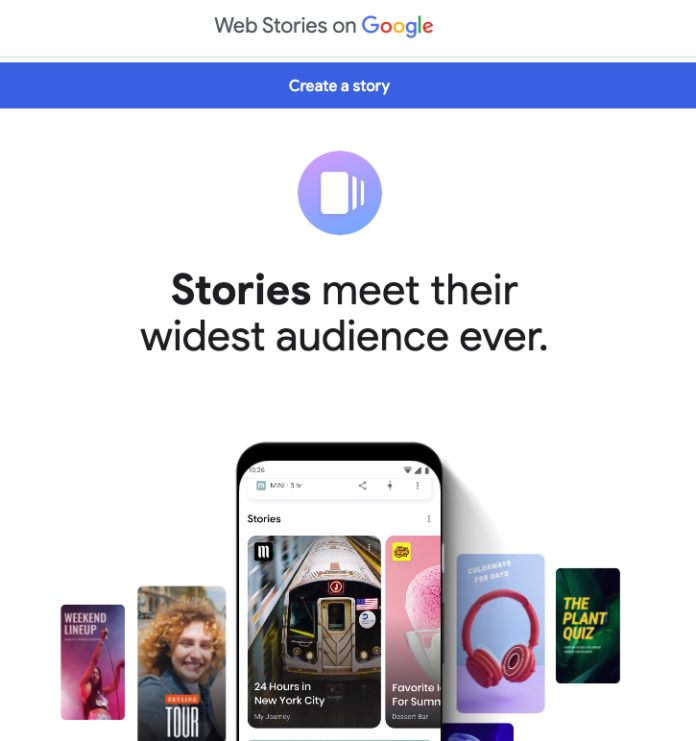What are Google Web Stories?
“Stories” are a huge part of social media and Google is taking note. From Snap to Instagram, stories offer individuals and businesses with short form content. These small snippets provide a quick look at a larger story. For Snap or Instagram, stories showcase a person’s day. However, Google stories show a headline that ideally drive clicks to your site.
As Google notes, Web Stories allow for complete control over your content, which means:
- You decide on how (or if) to monetize the content.
- Owning the design to ensure it meets your brand.
- Providing immersive content (via full screen video, photo and/or audio seamlessly).
- Connecting stories with other content (via embeds or links).
In a noisy and crowded world, people rely on authentic messages to stand out and marketers are no different. The introduction of Stories to the online world allows people to connect with their community beyond a simple photo or text update. As a result, authenticity reigns supreme as Google notes in the context around Web Stories.
“For creators and publishers, Web Stories are entirely under your direction, just like any other content on your website. Story authors are in full control of monetization, hosting, sharing and adding links to their Stories. Plus, the web offers one of the largest audiences for creators, with publishers already seeing strong results, as shown in the stories.google showcase. And because Web Stories are just an extension of a website, some early adopters of Web Stories are showcasing their stories on their home page, social channels, newsletters and more.”
Finally, Web Stories differ from other social media platforms because Google is not a pure social media platform. This means, Google integrates Web Stories with other search results and not your own network. Therefore, Web Stories work as a natural extension of your existing marketing plans.
How do Web Stories fit into my marketing plan?
Web Stories act as an extension of your marketing plan. However, keep in mind that Web Stories aren’t necessarily a must have and you need the right marketing team and brand to really cultivate the feature. For example, companies that have a lean marketing team or focus on a more tried and true audience, don’t really need to focus on Web Stories. However, emerging brands, particularly e-commerce or software based, that need to build awareness and target a large audience can really take advantage of the feature. Additionally, Google made it relatively easy to showcase Web Stories by incorporating the content into their other leading options, like Search, Discover, Images and App.
Additionally, as Search Engine Journal highlights, Web Stories are effective at drawing attention from mobile users and converting into more traffic.
“Publishers are adopting the web story format because it can be featured in an attractive way for mobile users. Web Stories represent a new way to obtain a significant amount of traffic.”
For example, as short form “snackable” content, Google recommends:
- Videos are no longer than 15 seconds and feature subtitles.
- Shooting videos in portrait mode, which displays in full screen on mobile.
- Including captions to all videos and images.
- Using a minimum of 24 font size.
- Not using more than 200 characters.
- Attaching a link to long form content.
The link feature allows individuals or companies to convert eyeballs from the Web Story to their site. Also, the links can include affiliate links, so Web Stories can be used with other ongoing monetization efforts. Pending your marketing team has the right messaging, Web Stories are a simple way to engage your audience (or potentially find new members of your core audience).
Why add Web Stories to your marketing strategy?
To start, Web Stories make a nice addition to your marketing strategy if you have the right brand and messaging. For those companies that seek to engage a younger audience or find most of their lead generation derives from mobile traffic Web Stories are certainly an option worth exploring. Additionally, Web Stories are open source and free!
To start testing and experimenting, then simply create a story and publish to your site! The content will be picked up by Google Discover and/or in regular search results. Plus, Google provides engagement stats, so you can gather data on the Web Stories and determine their effectiveness.
What is the easiest way to use Google Web Stories?
First and foremost, Google released a simple Web Stories plugin for WordPress supported sites. There are a handful of requirements and “best practices” (as noted above), but fortunately, the WP plugin features templates that anyone can leverage, along with an easy drag and drop interface. As a result, WP makes it pretty seamless to get started with Web Stories. (Of note, the Web Stories WordPress plugin requires a minimum WordPress Version of 5.3.1, along with a minimum PHP version of 5.6.)
Secondly, Google partnered with Unsplash to provide free stock images and Coverr for videos to plugin users!
Finally, Google notes the other plugin features that helps reduce the technical effort required to effectively leverage Web Stories.
“The Web Stories format comes with preset but flexible layout templates, standardized UI controls, and components for sharing and adding follow-on content…[and] can be shared and embedded across sites and apps without being confined to a single ecosystem. [The plugin] supports analytics and bookend capabilities for viral sharing and monetization.”
For more, Google released a guide on enabling Web Stories as well.
Ultimately, companies that leverage WordPress have a nice technical advantage to experiment with Web Stories. The partnerships help marketers without many creative resources. Stories require great images, so the partnerships help design aesthetically pleasing content snippets. In mobile, high quality images make a huge difference, so take advantage of the stock images to capture your audience’s attention and drive more traffic to your site.





